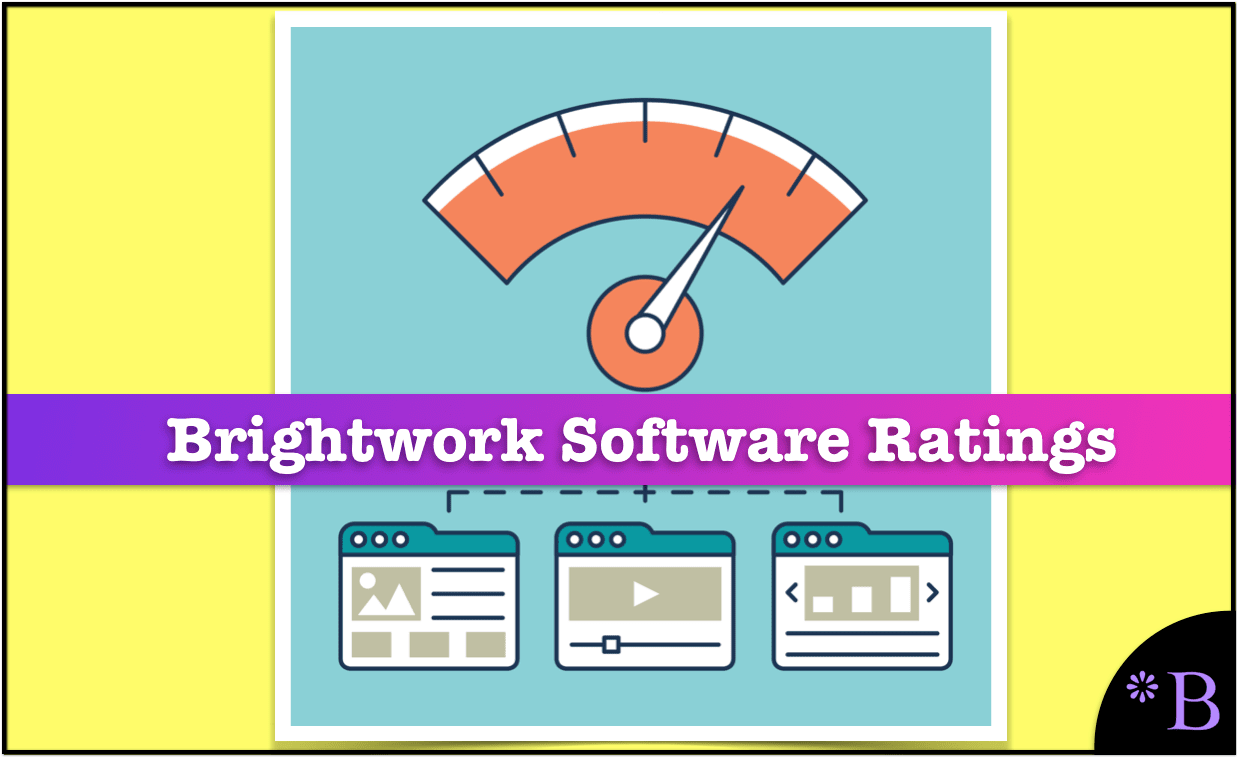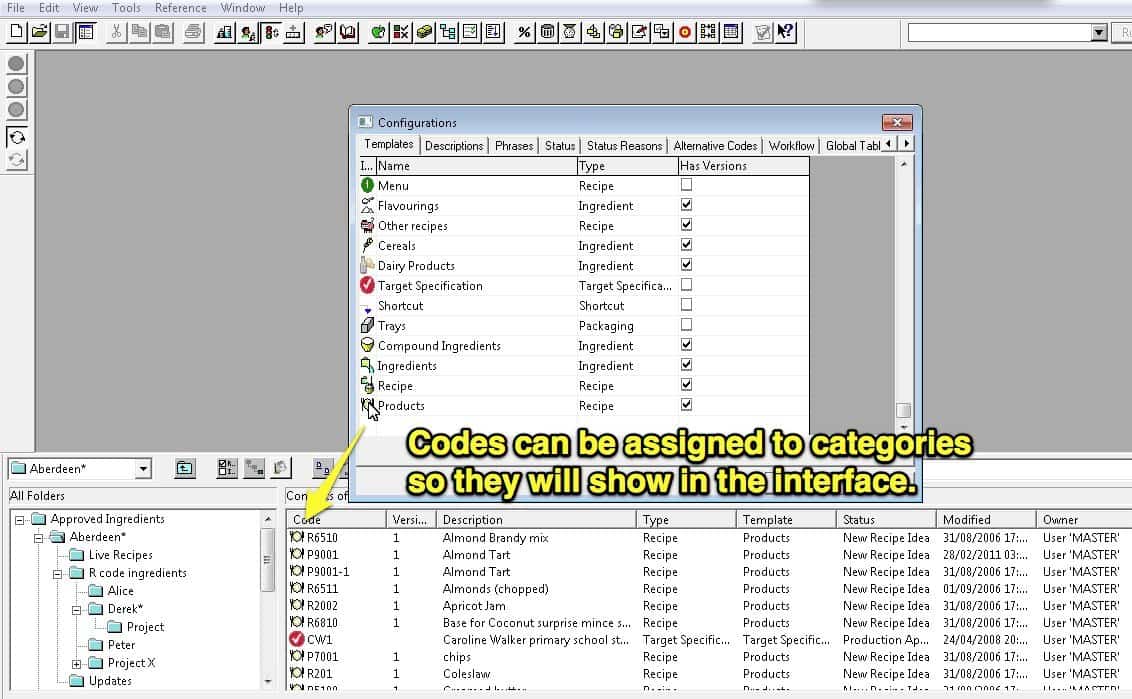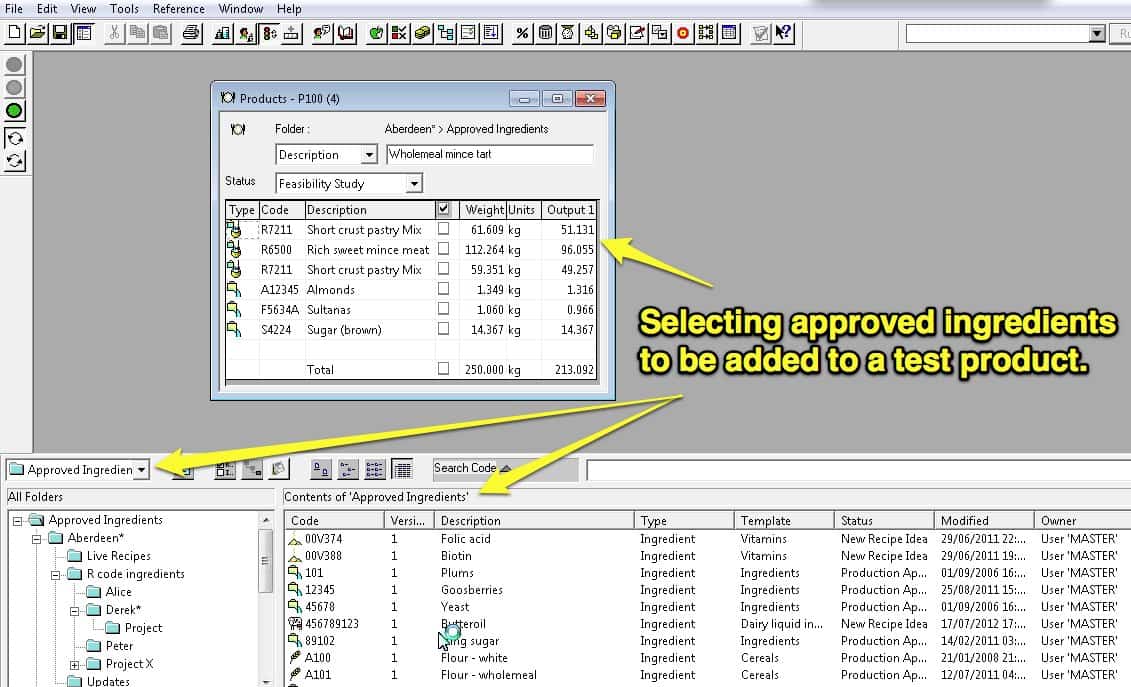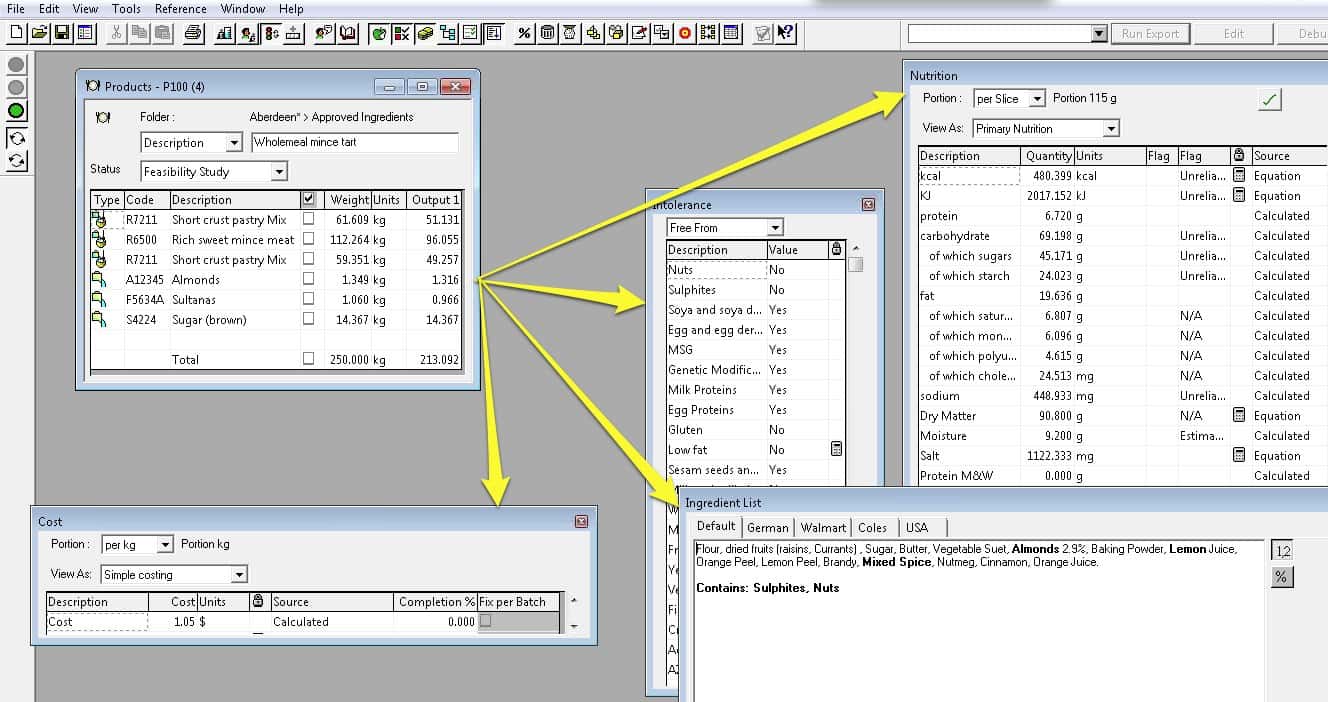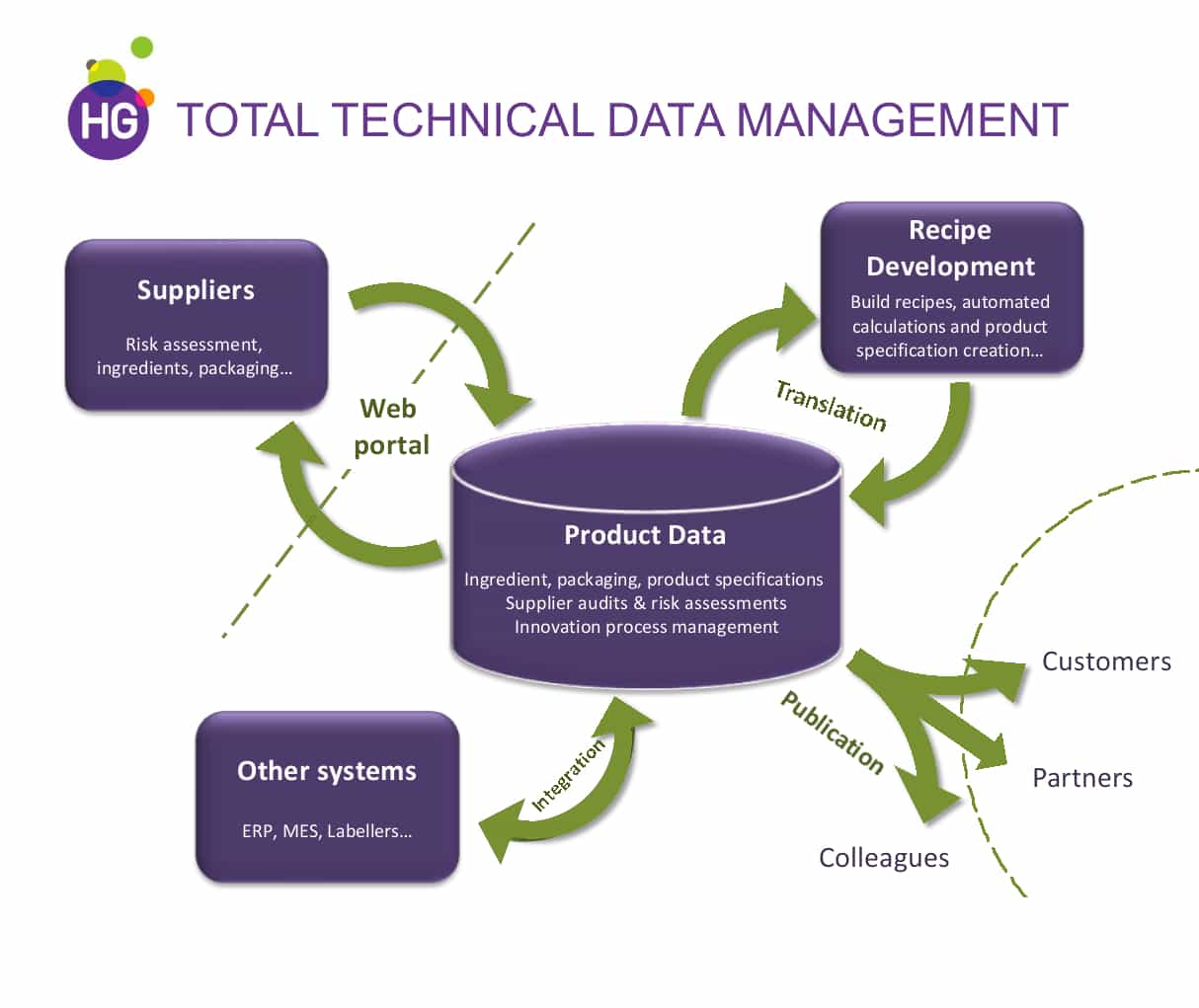Executive Summary
- This is the Brightwork Research & Analysis software rating series.
- We rate both the software and estimate the risk of implementing each application.
MUFI Rating & Risk for Hamilton Grant Recipe Management
MUFI: Maintainability, Usability, Functionality, Implement ability
Vendor: Hamilton Grant Recipe Management (Select For Vendor Profile)
Introduction
Hamilton Grant Recipe Management is a solution for managing product management.
The paper What Makes Process Process? makes the excellent point that the classic BOM tends to assume discrete or repetitive manufacturing. In the discrete or repetitive BOM, many parts are combined to make a single item. However, this is only one configuration. For instance with a poultry processor on chicken (the raw material), multiple finished goods result. Frequently the BOMs for the process industry are multi-level and can be one to two levels deep or up to fifteen or more levels deep. A multi-level BOM is explained well in the article Managing Multi-
Level BOMs, by Arena Solutions.
A multi-level BOM, also referred to as an indented BOM, depicts parent-child relationships and shows the hierarchical structure of assemblies and their related parts and components. A multi-level BOM is essentially a nested list whose parts or items are listed in two or more levels of detail to illustrate multiple assemblies within a product’s BOM. In contrast, a single-level BOM depicts one level of children in an assembly and only the components needed to make the assembly are listed.
Most of the recipe management applications that currently exist are directed towards the food and beverage industry. This is thought to be because of their stringent requirements, many of which were described above. Change is a constant feature of food and beverage product information as these companies will frequently reformulate their recipes for every production batch. Hamilton Grant’s software can greatly reduce the effort involved in doing this because they have functionality that can optimize the reformulation process – such that the objectives are set for the application and the application will meet these objectives at the lowest cost. Therefore, the optimizer determines what the new formula will be.
Recipe management software can be found outside of the food industry, but the selection quickly narrows. The differentiation between a BOM and a recipe is most easily seen inside of an application like Hamilton Grant. This is because their application provides the type of information that show ingredient aggregation as the food designers are building a new recipe, they must know how various indicators are changing and whether they have exceeded the specification as food must increasingly meet certain nutritional and other various compositional targets.
To begin, the icons that show up in the application can be set by the system configurator.
As with all useful recipe/BOM management applications, designers use them intensively, and many of the iterations that they create will never find their way to the production planning system. However, the sub-portion of the overall recipes that are created can be sent to ERP systems (and from there to planning systems) in a complete form. Recipe/BOM management systems allow for the natural duplication of recipes by using a template before developing a new design or product. In the case above, a food designer is adding a series of ingredients (which are only approved ingredients) that will make up a new mincemeat pie. As the food designer combines components, the characteristics of the product are totaled below. The Hamilton Grant Recipe Management application can hold a wide variety of ingredient characteristic, but only a few are shown in this view. A right mouse–click allows the designers to add and delete the components that will show in the user interface so they can see the summation of the ones that interest them.
New windows can be opened which show more a detailed analysis of the new product that is being designed. In this screenshot, you can see the costs, intolerance, nutritional content and the ingredient list. These perspectives on the product help the designer make adjustments to the products that meet the design objectives. For instance, food companies very much design their products in a way that result in a marketable food label. By viewing the label each time a new ingredient is added or removed, the food designer can make the adjustments to result in the desired food label.
The strength of these types of applications is that the information that is created in them is shared with many other applications. They serve as a hub for product data— a far superior approach to the poor design of using ERP systems as the hub of product data. In fact, the ERP-centered approach to being the product data hub has been attempted extensively and has been proven not to work well. Even so, it is still the dominant approach employed in companies. When companies follow this approach, ERP systems end up being a bottleneck to the implementation of other systems that rely on product information.
Hamilton Grant’s software is used first by product design before anyone from supply chain touches the recipe or formula. Product design makes numerous revisions (copies of new recipes and formulas) before a production recipe is created. Even after the production recipe is created, there are still more copies that are made as the product is changed through its lifecycle or as other copies of the recipe are created. Hamilton Grant’s ability to manage large numbers of revisions and to store them all—and to allow anyone with the access rights to see them—is a major strength of the application.
Once the interaction between various software applications and the recipe are understood, the next step is to learn how to leverage applications that use the recipe. I believe that individuals have difficulty understanding the recipe in its comprehensive form because existing literature does not include application screenshots to show how the recipe looks in different applications. While some product manuals produced by the recipe management vendors come close and are quite good, the manuals focus exclusively on a particular vendor’s application and do not show how the recipe looks in competing applications. As a result, few people receive the benefit of a comprehensive education in this area, which is a primary reason why the recipe tends to be so poorly managed generally.
Hamilton Grant Recipe Management is an easy decision for companies looking for recipe management in the food industry. However, an interesting question for other process industry buyers is whether this application could also help them with their recipe management. We would suggest that other process industries manufacturing companies, outside of food and beverage give Hamilton Grant Recipe Management a look. There are really few solutions in this area, and we estimate this category of enterprise software to have the highest ROI of any of the categories that we cover.
MUFI Scores
All scores out of a possible 10.
MUFI Scores
- Ma. = Maintainability
- Us. = Usability
- Fu. = Functionality
- Im. = Implementability
| App | Ma. | Us. | Ft. | Im. | Cat. |
|---|---|---|---|---|---|
| Average Score for Big ERP | 5.1 | 4.8 | 5.2 | 5.4 | Big ERP |
| Average Score for CRM | 6.2 | 6.2 | 5.1 | 5.9 | CRM |
| Average Score for Small and Medium ERP | 8.3 | 8 | 6.7 | 8.5 | Small and Medium ERP |
| Average Score for Finance | 8.8 | 8.8 | 8 | 8.8 | Finance |
| Average Score for Demand Planning | 7.6 | 7.2 | 7 | 7.1 | Demand Planning |
| Average Score for Supply Planning | 6.7 | 6.9 | 7 | 6.8 | Supply Planning |
| Average Score for Production Planning | 6.8 | 6.9 | 7 | 6.9 | Production Planning |
| Average Score for BI Heavy | 5.5 | 5.3 | 6.9 | 5.3 | BI Heavy |
| Average Score for PLM | 7 | 7.2 | 6.8 | 7.3 | PLM |
| Average Score for BI Light | 7.7 | 8.7 | 9 | 8.3 | BI Light |
| Arena Solutions Arena PLM | 10 | 10 | 10 | 10 | PLM |
| AspenTech AspenOne | 4 | 8 | 10 | 7 | Production Planning |
| Birst | 8 | 8.5 | 10 | 8 | BI Light |
| ERPNext | 10 | 10 | 7.5 | 10 | Small and Medium ERP |
| Delfoi Planner | 8 | 6 | 6.5 | 7 | Production Planning |
| Demand Works Smoothie SP | 9 | 10 | 7 | 10 | Supply Planning |
| Hamilton Grant RM | 10 | 9 | 8.5 | 9 | PLM |
| IBM Cognos | 2.7 | 3 | 1.5 | 3 | BI Heavy |
| Infor Epiphany | 7 | 8 | 6 | 5 | CRM |
| Infor Lawson | 8 | 7 | 6 | 7 | Big ERP |
| Intuit QuickBooks Enterprise Solutions | 9 | 9 | 5 | 9 | Finance |
| JDA DM | 9 | 7.5 | 8 | 8 | Demand Planning |
| Microsoft Dynamics CRM | 2 | 3 | 2 | 2 | CRM |
| NetSuite CRM | 6 | 4 | 3 | 3 | CRM |
| Netsuite OneWorld | 7 | 7 | 8 | 8 | Big ERP |
| OpenERP | 7 | 8 | 8.5 | 8 | 7 |
| Oracle BI | 4 | 4 | 3 | 6 | BI Heavy |
| Oracle CRM On Demand | 4 | 5 | 3 | 5 | CRM |
| Oracle Demantra | 5 | 3 | 3.5 | 4.5 | Demand Planning |
| Oracle JD Edwards World | 4 | 1 | 3 | 6 | Big ERP |
| Oracle RightNow | 6 | 7 | 4 | 5 | CRM |
| PlanetTogether Galaxy APS | 10 | 10 | 10 | 10 | Production Planning |
| Preactor | 8 | 7 | 3 | 7 | Production Planning |
| QlikTech QlikView | 9 | 9 | 10 | 9 | BI Light |
| Rootstock | 9 | 8 | 9 | 9 | Small and Medium ERP |
| Sage X3 | 8 | 8 | 7 | 8 | Big ERP |
| Salesforce Enterprise | 8 | 8.5 | 9 | 7.5 | CRM |
| SAP APO DP | 3 | 4 | 3 | 2 | Demand Planning |
| SAP APO PP/DS | 2 | 2 | 4 | 3 | Production Planning |
| SAP APO SNP | 3 | 4 | 8 | 4 | Supply Planning |
| SAP BI/BW | 1.5 | 2 | 4 | 2 | BI Heavy |
| SAP Business Objects | 3 | 2.5 | 7 | 3 | BI Heavy |
| SAP CRM | 4 | 3 | 6 | 4 | CRM |
| SAP ECC | 3 | 3 | 6.5 | 3 | Big ERP |
| SAP PLM | 1 | 2.5 | 2 | 3 | PLM |
| SAP SmartOps | 4 | 4 | 7 | 5.5 | Supply Planning |
| SAS BI | 6.5 | 7 | 9 | 6 | BI Heavy |
| SAS Demand Driven Forecasting | 7 | 8 | 9 | 7 | Demand Planning |
| Tableau (BI) | 9 | 10 | 10 | 10 | BI Light |
| Tableau (Forecasting) | 10 | 8 | 5 | 9 | Demand Planning |
| Teradata | 8 | 6.3 | 9.7 | 6 | BI Heavy |
| ToolsGroup SO99 (Forecasting) | 7 | 8 | 9 | 7 | Demand Planning |
| ToolsGroup SO99 (Supply) | 5 | 6 | 10 | 7 | Supply Planning |
Vendor and Application Risk
Buyers of Hamilton Grant Recipe Management have the advantages working their direction. Hamilton Grant Recipe Management is one of highest rated application in PLM/recipe management for food and beverage. It is a rare situation where a buyer has the opportunity to purchase software that is both the functionality leader in its category, along with being highly implementable and user-friendly. Because Hamilton Grant has such a high combined application and software vendor risk rating, the vast majority of the risk comes from the buyer’s environment, not from Arena PLM. User adoption with Grant Hamilton Recipe Management should be high, and with the ability to quick revisions to recipes to create new products, post goes live the overall satisfaction should also be high.
Likelihood of Implementation Success
This accounts for both the application and vendor-specific risk. In our formula, the total implementation risk is application + vendor + buyer risk. The buyer specific risk could increase or decrease this overall likelihood and adjust the values that you see below.
Likelihood of Application Implementation Success and Failure
Search for the application in this table using the search bar in the upper right of the table.
| Application | Prob of Implementation Success | Prob of Implementation Failure |
|---|---|---|
| Actuate | 0.77 | 0.23 |
| SAP Smartops | 0.39 | 0.61 |
| NetSuite CRM | 0.46 | 0.54 |
| Sugar CRM | 0.62 | 0.48 |
| Base CRM | 0.91 | 0.09 |
| SAP CRM | 0.35 | 0.65 |
| Salesforce Enterprise | 0.72 | 0.28 |
| QlikTech QlikView | 0.82 | 0.18 |
| Tableau (BI) | 0.98 | 0.02 |
| SAP Crystal Reports | 0.46 | 0.54 |
| Brist | 0.83 | 0.17 |
| MicroStrategy | 0.7 | 0.3 |
| SAS BI | 0.76 | 0.24 |
| Oracle BI | 0.35 | 0.65 |
| IBM Cognos | 0.23 | 0.77 |
| Infor Epiphany | 0.58 | 0.42 |
| Microsoft Dynamics CRM | 0.26 | 0.74 |
| Oracle RightNow CRM | 0.41 | 0.59 |
| Oracle CRM On Demand | 0.36 | 0.64 |
| Teradata | 0.76 | 0.24 |
| SAP Business Objects | 0.32 | 0.68 |
| SAP BI/BW | 0.25 | 0.75 |
| SAP PLM | 0.29 | 0.71 |
| Hamilton Grant RM | 0.89 | 0.11 |
| Arena Solutions | 0.96 | 0.04 |
| Delfoi Planner | 0.7 | 0.3 |
| Preactor | 0.64 | 0.36 |
| PlanetTogether Galaxy APS | 0.96 | 0.04 |
| AspenTech AspenOne | 0.55 | 0.45 |
| SAP APO PP/DS | 0.27 | 0.73 |
| Demand Works Smoothie SP | 0.93 | 0.07 |
| ToolsGroup SO99 (Supply) | 0.82 | 0.18 |
| Demand Works Smoothie | 0.96 | 0.04 |
| Tableau (Forecasting) | 0.9 | 0.1 |
| SAS Demand Driven Forecasting | 0.82 | 0.18 |
| ToolsGroup SO99 (Forecasting) | 0.86 | 0.14 |
| JDA DM | 0.57 | 0.43 |
| Oracle Demantra | 0.33 | 0.67 |
| SAP APO DP | 0.28 | 0.72 |
| FinancialForce | 0.92 | 0.08 |
| Intacct | 0.98 | 0.02 |
| Intuit QB Enterprise | 0.8 | 0.2 |
| ERPNext | 0.9 | 0.1 |
| OpenERP | 0.78 | 0.22 |
| Rootstock | 0.91 | 0.09 |
| ProcessPro | 0.93 | 0.07 |
| Microsoft Dynamics AX | 0.4 | 0.6 |
| SAP Business One | 0.49 | 0.51 |
| Sage X3 | 0.62 | 0.38 |
| Infor Lawson | 0.58 | 0.42 |
| Epicor ERP | 0.4 | 0.6 |
| Oracle JD Edwards World | 0.31 | 0.69 |
| Oracle JD Edwards EnterpriseOne | 0.36 | 0.64 |
| SAP ERP ECC/R/3 | 0.32 | 0.68 |
| NetSuite OneWorld | 0.65 | 0.35 |
Risk Definition
See this link for more on our categorizations of risk. We also offer a Buyer Specific Risk Estimation as a service for those that want a comprehensive analysis.
Risk Management Approach
The only implementation issues that a buyer of Arena PLM can expect to the fact are the traditional issues that face PLM/recipe management implementation projects. Buyers and product managers should look forward to a Hamilton Grant Recipe Management implementation.
Finished With Your Analysis?
To go back to the Software Selection Package page for the BI Light software category. Or go to this link to see other analytical products for Hamilton Grant Recipe Management.
